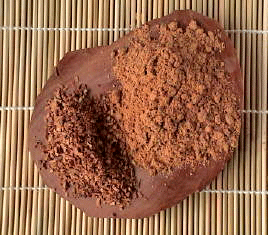Sandalwood Q&A - an Ayurveda View
Date Posted:10 January 2011

Q: Where does Sandalwood come from?
A: Sandalwood comes from the Sandal Tree, known scientifically as Santalaceae Santalum Album and in Sanskrit as chandana. In English it is called White Sandalwood or Yellow Sandalwood depending on the age of the tree. An evergreen tree that grows only in the southern areas of India, Indonesia and somewhat in Australia, it grows to a medium height of 30 feet. After 15-20 years the oil collects in the heartwood, or the center of the trunk, but as the scent of sandalwood grows stronger, the color of the wood becomes more yellow. The value of the wood climbs higher the older the tree. It is considered at its peak at 60 years old.
When harvested the heartwood is ground into powder and then steam-distilled into oil for use in cosmetics, soaps, candles, medicines and perfumes. The hard, yellow, outer wood is mostly used for carving statues and decorative articles such as combs, beads and boxes.
Q: Why is the Sandal tree so important to the Vedic tradition?
A: The Sandal tree is highly regarded in the Vedic texts, and the heartwood is considered to be sacred. It is said that chandana, or Indra's Sandalwood tree, scents the whole of paradise with its fragrance. Sandalwood is considered the epitome of excellence, imparting fragrance even to the axe that cuts it. For this reason anything that is excellent is referred to as chandana. It is used in sacred ceremonies and to purify holy places.
Q: What are the medicinal uses of Sandalwood oil or powder?
A: When used externally, Sandalwood oil or Sandalwood paste (made from mixing water with Sandalwood powder) has a calming, cooling effect on body and mind. It helps relieve fever and burns, and stops excessive sweating. In general it relieves Pitta dosha and helps balance the body after overexposure to the sun. The oil or the paste can help heal skin diseases such as infectious sores, ulcers, acne and rashes. Sandalwood powder helps smooth and cool the skin, and can be made into a paste, lotion or soap for cleansing, calming and hydrating sensitive or aging skin. Sandalwood acts as a disinfectant, diuretic, expectorant and sedative. It is bitter, sweet, astringent and cooling. Sandalwood balances the circulatory, digestive, respiratory and nervous systems.
Q: What is the effect of Sandalwood in aromas or incense?
A: Sandalwood incense is made from rolling the paste of the sapwood on bamboo skewers by hand. The scent of Sandalwood essential oil or Sandalwood incense clarifies the mind and helps to awaken intelligence, and is often used as an aid for meditation. It calms the mind, soothes stress and nervous tension, and uplifts the mood. It is said to enliven courage, purpose, strength and happiness.
Q: Sandalwood is reportedly on the endangered list of trees in India. What are the challenges involved in obtaining good sandalwood?
A: The Sultan of Mysore declared Sandalwood to be a royal tree in 1792. Every Sandalwood tree is still under the protection and ownership of the Indian government today, even when grown on private land. The individual who owns the land receives 75% of the proceeds in return for planting and protecting the tree until it reaches maturity. Due to an increased demand in medicines, perfumes and cosmetics that contain Sandalwood oil, and due to the decreased availability as smugglers cut down trees and export them illegally, prices have skyrocketed in recent years. At this time it is illegal to export the wood from India, although the oil can be exported.
Q: What about Red Sandalwood? Is it the same thing?
A: Red Sandalwood comes from an entirely different species (Pterocarpus Santalinus), related to the legume family, and grows in the Caribbean and Indonesia as well as India. It is used to balance digestion and skin health, and also helps balance purification through the sweat glands and skin. It is found in Healthy Hair and Nails, Elim-Tox, Radiant Skin, and Vital Lady. Red Sandalwood also is used as a dye, as incense, and as a decorative powder in sacred ceremonies.


